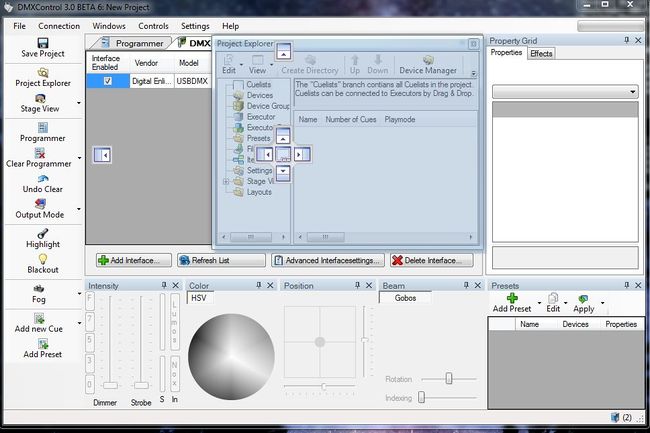Overview
In this lessons you will learn how to operate with the panel system of DMXControl 3.0. You can assign your panels in a flexible way and save and restore your favorite configurations.
Lecture 2: The panel concept of the DMXControl 3 client
DMXControl 3 provides a lot of tools and windows. For different use cases different designs will be in focus. Therefore DMXControl uses a very flexiblel panel mechanism. You can create your own individual panel configurations. The forms in the program can be unlocked to float above the main window or can be docked to the top, bottom, left or right margins. This versatility gives you the power to build screens that are easy to use and tailored to your personal preference and to move panels to several monitors. Catch a form with the mouse pointer and move the pointer over one transparent arrow to dock the form at wanted places. A panel can also be set to occupy the left-over space in the middle (pic.1).

|
| Figure 1: Panel assignment |
Some important explanations:
- A "floating" form is simply one that isn’t docked to any side.
- A pane or panel is a container for several forms.
- The docking suggestion is a symbol indicating the options where a form can be docked. It is available both in the main window and in each pane. The potential position of the form is indicated by a blue rectangle.
- Forms are created via the "Windows" system and are closed with the ‘X’ in its top right corner. This will close the form but leave other forms in a pane untouched.
- The (vertical) push-pin is the small pin icon that appears by default within docked forms that are shown permanently. Clicking the push-pin changes the forms status to hide-away form, i.e. the form becomes unpinned and disappeares, but a tab is created within the pane.
- pane splitting - a pane can be splitted into 2 visible panes
- pane sharing - several forms share a pane, but only the top one is displayed, the other ones are in status "auto hide"
Panes
A docking pane can accommodate more than one form. A pane is automatically created by docking more than one form. All forms contained are represented by a tab strip. Moving the mouse curser over the tab displays the form (but it doesn't get the focus). By clicking the tab the form is brought into front (with getting the focus).
There are several ways for releasing docking and getting a floating window:
- After creation a form is already floating
- Double-click on the blue or grey header bar of a docked form
- Double-click on the tab of a docked form
- Click, hold and drag on the header bar of a form
- Click, hold and drag on the tab of a form
Once a form is floating it can be dragged to be docked anywhere.
Even within a panel you have new docking suggestion points for pane splitting.
Pane-splitting
By dragging the floating window and positioning your mouse cursor near the pane you get an internal docking suggestion. You can get the two windows to split the space in half and see both, but with only half the space each. This can be done vertically or horizontally. In the upper example (Picture 1) the floating window "Project Explorer" would share the space with the "Programmer" if you release the mousebutton.
Pane Sharing
As an alternative to pane-splitting, you can get your windows to share a space – they will share a single pane. You choose the form to be seen from the tabs displayed at the edge of the pane. Drag the floating form so that the mouse cursor is over the top of the form. There are two slight variations on this, depending on the original form occupying the space. The form can be:
- Docked on the side
- Filling the spare space in the middle (a ‘Document’ form)
If you add more forms to the pane than there is room to display the tab, he left and right arrows become active and can be used to show the tabs that are hidden.
Hideaway Forms
When you click the push-pin at the top of the forms next to the close-down ‘X’, it falls over. The form becomes ‘unpinned’ and appears to slide off the edge of the screen. The remaining screen re-arranges itself and the space previously taken by the hideaway form is shared out amongst the nearby forms (pic.2.
| |
The push-pin applies to the PANE, not to a single window in it. When forms are sharing a pane they are hidden or revealed together. |
Error creating thumbnail: File missing
|
| Figure 2: Unpinned windows |
In this panel configuration the left, right and bottom panel are used. The left panel is a splitted one. The right panel containes one auto-hide window (see tab strip). The Project Explorer window is floating.
Auto-Hide
DockPanel has an auto-hide feature that can be very useful. If there is any auto hide window, DockPanel will display a tab strip on the out-most edge. An auto hide window has 3 statuses:
- hide
- mouse-hover-display and
- click-display.
In hide status, only the tab is displayed. The window itself is completely hidden. That can preserve the valuable screen to display more information.
Save/Restore Layout settings
You can save and restore your individual layout setting by menu Settings->Layout.
Further information
The handling of different panels is based on Dockpanel suite of Weifen Luo (also some text reused). [1]
Excercise
- Create a new form (Menu "Windows") and dock and relaese it at several positions
- Save and reload your own panel configuration
Additional links and references
I have understood the topics of this lecture and want to continue with next course: Lesson 3